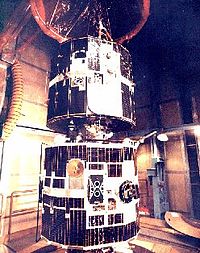- Dynamics Explorer
-
Dynamics Explorer 
Dynamics Explorers 1 and 2 prior to launch on a Delta booster.Operator NASA Mission type Atmospheric observation Satellite of Earth Orbital insertion date 9/3/81 Launch vehicle Delta 3000 COSPAR ID 1981-070A Mass 424 Kg each Power 86 watts Orbital elements Orbital period 98 minutes Dynamics Explorer was a NASA mission, launched on August 3, 1981 and terminated on February 28, 1991. [1] It consisted of two unmanned satellites, DE-1 and DE-2, whose purpose was to investigate the interractions between plasmas in the magnetosphere and those in the ionosphere. [2] The two satellites were launched together into polar coplanar orbits, which allowed them to simultaneously observe the upper and lower parts of the atmosphere.
Contents
Design
Both spacecraft had a polygonal shape, and were approximately 137 cm in diameter and 115 cm high. Each also had a 200-cm radio antenna and two 6-meter booms which were needed to distance some of the equipment from the main body of the spacecraft. They were stacked on top of each other and launched aboard a Delta 3000 booster rocket. Upon reaching orbit, the two spacecraft departed from the booster and entered separate orbits. Dynamics Explorer 1 was placed into a high altitude elliptical orbit, while DE-2 was put into a lower orbit that was also more circular.
Dynamics Explorer 1 Instrumentation
The main instrument aboard Dynamics Explorer 1 was the Plasma Wave Instrument (PWI). This instrument, designed and built by the Plasma Wave Group, measured auroral kilometric radiation, auroral hiss, Z-mode radiation, and narrow band electromagnetic emissions. Additional Instruments aboard the spacecraft included:
- The Spin-scan Auroral Imager (SAI)
- The Retarding Ion Mass Spectrometer (RIMS)
- The Energetic Ion Mass Spectrometer (EIMS)
Dynamics Explorer 2 Instrumentation
The Dynamics Explorer 2 carried the following instruments for data collection:
- A Retarding Potential Analyzer, which measured the ion flux along the velocity vector of the spacecraft. This data was then used to determine the ion temperature and drift velocity in the spacecraft's area. [3]
- An Ion drift meter, which measured the ambient ion drift.
- A Magnetometer
- A Vector Electric Field Instrument
 An aurora as seen by one of the Dynamics Explorers
An aurora as seen by one of the Dynamics Explorers
- A Neutral Atmosphere Composition Spectrometer
- A Wind and Temperature Spectrometer
- A Fabry–Pérot interferometer
- A Low-Altitude Plasma Instrument
- A Langmuir probe
Mission Results
As a result of a malfunction in the Delta 3000 booster rocket in which its main engine shut off slightly early, DE-2 was placed into a slightly lower orbit than was anticipated. This was not a serious problem, however, and the spacecraft had lasted its expected lifespan when it re-entered the Earth's atmosphere on February 19, 1983. DE-1, being in a higher orbit, continued to collect data until 1991, when the mission was officially terminated.
References
Explorer program Explorer 1 · 2 · 3 · 4 · 5 · 6 (S-2) · 7 (S-1a) · 8 · 9 (S-56A) · 10 · 11 (S-15) · 14 (EPE-B) · 17 (AE-A) · 30 (Solrad 8) · 32 (AE-B) · 33 (IMP-D) · 35 (IMP-E) · 37 (Solrad 9) · 42 (Uhuru) · 44 (Solrad 10) · 48 (SAS B) · 49 (RAE-B) · 52 (Hawkeye 1) · 53 (SAS C) · 57 (IUE) · 58 (HCMM) · 59 (ICE) · 62 (DE-1) · 63 (DE-2) · 64 (SME) · 66 (COBE) · 67 (EUVE) · 68 (SAMPEX) · 69 (RXTE) · 70 (FAST) · 71 (ACE) · 72 (SNOE) · 73 (TRACE) · 74 (SWAS) · 75 (WIRE) · 77 (FUSE) · 78 (IMAGE) · 79 (HETE-2) · 80 (WMAP) · 81 (RHESSI) · 82 (CHIPSat) · 83 (GALEX) · 84 (Swift) · 85 thru 89 (THEMIS) · 90 (AIM) · 91 (IBEX) · 92 (WISE)
Italics indicate probes that failed to deploy or otherwise malfunctioned Categories:- Artificial satellites orbiting Earth
Wikimedia Foundation. 2010.
